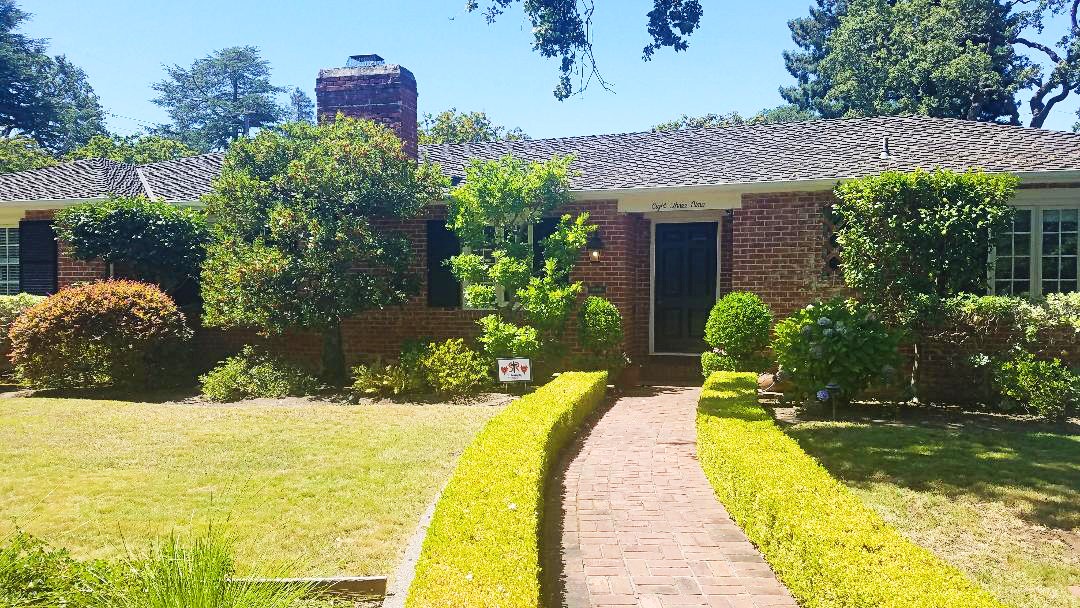Redwood City was home to the “house of the future” during the 1939 Golden Gate International Exposition, an event that drew more than 10 million visitors to the new Treasure Island, constructed in the middle of San Francisco Bay for the festivities.
The Redwood City Tribune forecast that “during the next few months thousands from all over the nation will visit this beautiful residence” at 839 Blandford Boulevard. (Note the significant use of the number 39 in the address.) Current owners Hunter and Holly Volk have never seen that level of interest, but they concede the house in the Edgewood Park area is a traffic-stopper of sorts.
“This place is neighborhood central” during the summer, Hunter Volk says while standing next to a window that looks out onto a backyard that forms the center of his U-shaped home. The term “backyard” scarcely applies; it’s more of a patio or a plaza that, in the old Spanish tradition, was the gathering place for a town’s citizens.
Built especially for the fair, the house was the pride of Redwood City.
During a quick tour of the 3,110-square-foot home, reportedly designed by Menlo Park architect Arthur D. Janssen, Hunter pointed out many art-deco touches, including a built-in vanity in one bathroom. Other reminders of times past are wall buzzers for summoning servants. Large windows and hardwood floors stand out as the dominant features of the three-bedroom, three-bath home.
“There are windows everywhere,” says prior owner Jodi Garehime. “I could have been the nosiest person in the neighborhood. I could see everything going on around us.” She and her husband Bill lived in the house for 33 years. “It was hard to leave,” Garehime adds. “We loved the place.”
Garehime says she heard a one-third scale model of the house was displayed at the Treasure Island exposition, which celebrated the opening of the Golden Gate and Bay bridges. Technically, the event was not a “world’s fair,” an official designation reserved for the 1939 extravaganza held in New York.
The house was not in the best shape in 1983 when the Garehimes moved in. They had to sandblast gray paint, which covered the bricks that make up the home’s exterior signature. In addition, bushes had been allowed to grow wild and covered a few windows. Garehime says it was “a labor of love” to get 839 back to its original glory.
—
This story first appeared in the September edition of Climate Magazine
—
Built especially for the fair, the house was the pride of Redwood City. The Tribune of July 18, 1939, announced in oversized letters that the town had its “Own Model Exposition Home.” In fact, the house was one of many for the fair, according to the Redwood City Historical Resources Inventory, a 2019 report prepared for the city government. Certain Bay Area houses were designated “homes of the future” to show fair visitors from other parts of the country how Californians might live. In addition to the Blandford house, other such homes on the Peninsula were in Burlingame, Menlo Park and Palo Alto.
The Tribune described the Redwood City house as “a modern adaptation of the early California period.” The house combined “simplicity with every modern feature of home construction,” the Tribune’s reporter continued, concluding that the “model home finds a perfect setting among the oaks.”
The San Francisco Chronicle featured an entire section on the homes, reporting that the Blandford house was the work of the local chamber of commerce and realty board. The Chronicle agreed with the Tribune that the house represented a variation of “the early California Hacienda.” In hindsight, it wouldn’t be much of a stretch to see the “rancher” label looming for the “house of tomorrow.”
The 1939 price? According to the architectural publication Pencil Points, the house was listed at $12,000. An adjacent lot was included.






